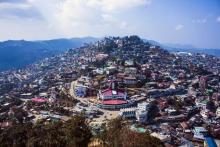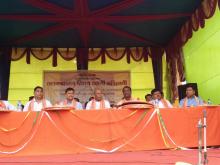The Bodo community of Assam is the worst sufferer of the policy of illegal migration for rise in the number of voters. This group of people are the most affected by the ‘Vote-Bank’ scheme of the Government of India in collaboration with successive Governments of Assam (demo-cratically elected since post-‘independence’).
The worst affected districts of Western Assam, due to such politically motivated “Chain Migration” has got an autonomous council, but only in name. The so called ‘minority’ calls the shots when a Government is to be formed at Dispur as well as Delhi. Parts of Western Assam are facing the brunt of such myopic policies of policy-makers who win elections on quantity of votes and not quality of votes. The student fraternity is the most affected by violence among different groups which spread out to different communities in no time…..like wild-fire it engulfs the dream of many meritorious students of either groups. Many students suffer due to bandhs and curfew and cannot attend schools and colleges during riots. They have to compromise with education. Schools have to provide shelter to people who have lost their houses and resources back in their villages. All government schools become temporary make-shift camps.
Let’s take the case of two young girls from the riot affected BTAD (Bodoland Territorial Autonomous Disctricts). They are not direct victims, but indirectly there Education suffers during periods of riot every now and then. Anima Hajuari (19) of Udalguri studied upto the tenth standard. She supports herself as a maid in service in different households. Anima, being born to an economically challenged family couldn’t avail tuitions to clear her exams properly. She tried to be as regular as possible in school. She says, “There are bandhs off and on. We miss classes. We miss lessons. The areas in subjects which are beyond understanding goes on left out and exams come by. Sometimes we have to lose valuable years of education as we cannot clear our test exams. The frequent bandhs and riots make the schools make-shift shelters for the riot affected people.”
There is the 22 year old nurse Sumitra Basumatary who has learnt to be financially independent because of a diploma course in nursing after matriculation exams. The vocational education has made her self-reliant. But she rues over the loss of working days in schools and her hopes of going to a college for graduation courses. Sumitra says, “Most of the time around the year, schools are off. Even if the teacher has to come as per government notice, how can the students come, especially the safety of girls is a matter of concern.” However, both Anima and Sumitra have accepted life as it comes and tries to be happy in the imperfections of life and living. Deep scars lay hidden in the dreams that catch fire every now and then.
Recently, Assam is in news because of the conflict between the native population and illegal immigrant Bangladeshis. The immigration took momentum in 1930s and later in 1970s. The flood gates of immigration have put immense pressure on the availability of land for cultivation.
Assam supplies 55 percent of the total tea produced in the country. It supplies almost 100 percent of India’s plywood needs. Over and above this, a considerable amount of coal, jute, timber, and 95 percent of the world’s syllemnite are produced in Assam. About Rs. 3000 crores (nearly $ 3 bn) worth of goods are pumped into the rest of India from Assam every year. (Tales of Western Inspiration and Indian Karma : Dilip K. Datta)
The first Mughal attack Assam was in 1205-06 A.D. Thanks to the superior military skill shown by the soldiers of Kamrup (ancient name of Asam), they had to abandon the plan to annex Assam into the Mughal empire. But things are not the same. Now we have a democracy, a democracy of numerical majority where the number of heads count more than borders. The flood-gates of immigration were thrown open by the provincial government of 1930s lead by Muslim League. It was against this background, that in his 1931 report, the then Census Superintendent, Mr. C.S. Mullan said, “In fact the way in which they (immigrants from East Bengal) have seized the vacant areas in the Assam Valley seems almost uncanny.” The silent invasion began around 1911 and the census report did mention of the horde which now has become politically motivated to the core because of their growing numbers in a ‘democracy of numbers’.
A friend of mine often relates to me of the surprising looks she invites whenever she speaks in Assamese in places other than North-East India. She surmises it might be because of her strong Mongoloid features. My experiences are no different. Whenever I venture outside the region, people find it hard to believe I am Assamese because of my well-built Caucasian looks.
Need we blame someone for this ignorance? For many people from the North-East, be it from any tribe, clan or community, it has become a habit to pass on the parcel to the so called ‘mainstream’ or the ‘Centre’. Let’s look at ourselves first. The reason behind such ignorance might be associated...







Add new comment